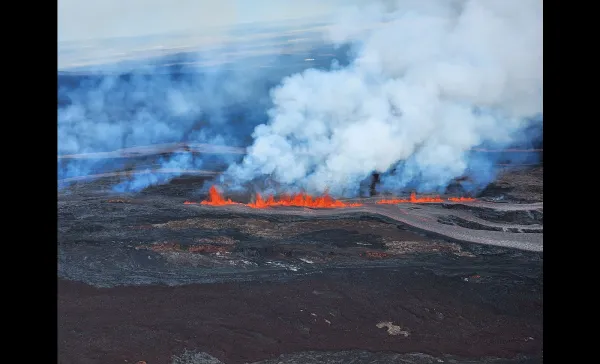By: Christian Haag
June 12 2023
No, Keeling Curve data has not been corrupted by emissions from the Mauna Loa volcano

The Verdict False
Data from the Mauna Loa Observatory is combined with data from the South Pole and screened to ensure that it is not corrupted.
Context
A video first posted to YouTube and later uploaded on TikTok claims that the data from the Keeling Curve has been corrupted because the equipment is situated on top of the Mauna Lua volcano in Hawaii. According to the video, the data is influenced not only by eruptions, but also by emissions from fissures in the volcano and other nearby volcanoes. Instead, the video suggests global warming is caused by natural processes. However, the claim is inaccurate.
In Fact
The Keeling Curve results from Dr. Charles David Keeling's measurements of global atmospheric carbon dioxide concentrations, which were first recorded in 1958 at Mauna Loa in Hawaii. Its precision, accuracy, and continuity make it one of the most important pieces of scientific evidence of the link between fossil fuel emissions, climate change, and the greenhouse effect.
The claim that the data is corrupted is false and was addressed by Dr. Keeling in 1960 when he started the measurements. Besides the measurement site in Hawaii, there is one in Antarctica and one in California. All three had some sort of local contamination, but California had the highest. By comparing the results with different locations, Keeling could exclude local contamination of the data and instead find that the atmospheric carbon dioxide concentration steadily increased. Consequently, as Skeptical Science writes, Keeling debunked the claims before they were made.
Over time, Keeling's data has revealed an annual increase in atmospheric CO2 and that this increase is roughly proportional to the amount of CO2 released in the atmosphere from the burning of fossil fuels. American Chemical Society writes that the synchrony between fossil fuel emissions, the greenhouse effect, and climate change became more and more apparent with time, and Keeling's data was the first to provide accurate measurements, making it possible for scientists to understand the connections.
According to Brittanica, Mauna Loa and the South Pole were chosen as measurement sites because of their distance from other carbon dioxide emission sources, such as cities and vegetation. The elevation at Mauna Loa also ensured unbiased data, along with the lack of vegetation, preventing data contamination from the photosynthetic activity and ensuring low adverse effects due to the volcano. All data is screened to locate and avoid influences in the data. For example, the data is influenced by the vegetation from lower altitudes of Mauna Loa due to afternoon updrafts. The combined data show a steady atmospheric carbon dioxide concentration increase over time.
During the 1980s, data from polar ice deposits revealed CO2 concentration levels as far as hundreds of thousands of years back, making it possible to extend the Keeling Curve when combining the two datasets. When merged, the data revealed that the level of CO2 had not been seen for more than 800,000 years, thus debunking claims that climate change is only due to natural processes.
It is also worth noting that many other organizations and research centers are monitoring and collecting data for understanding climate change, such as Advanced Global Atmospheric Gases Experiment, which collects data from 11 locations; Polar Portal, studying the Greenland ice sheet and the sea ice; and Argo, that studies ocean temperatures.
The Verdict
As Dr. Keeling clarified and refined his own data collection in the 1960s and considering the lengths scientists have gone to ensure unbiased data, we have marked this claim as false.


